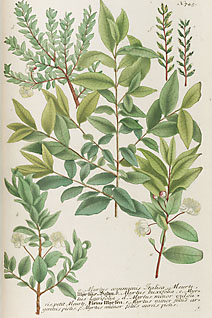Mercurial Myrtle
By Audrey Stallsmith

"Then give me that, meantime, to comfort me," said he, half jestingly and half in earnest, extending his hand for the sprig of myrtle.
"No, indeed, I shan't."
"Do! Pray do! I shall be the most miserable of men if you don't. You cannot be so cruel as to deny me a favour so easily granted and yet so highly prized," pleaded he as ardently as if his life depended on it.
Agnes Gray by Anne Bronte
There is a reason that the above gentleman begged so ardently for that sprig! Myrtle, once thought sacred to both Venus and Aphrodite, has long been considered a symbol of love. So a girl's giving of it to her gentleman caller would have had deeper implications.
Because it stands, in the Language of Flowers, for "love," "marriage," and "love in absence," no Victorian wedding would have been complete without myrtle. Besides, it is supposed to be a lucky plant, provided that it flourishes. So the fact that mine, which I grew in a pot for several years, never bloomed and eventually shriveled probably isn't a good sign--at least for my romantic prospects!
A couple myrtle trees with the names Plebian and Patrician reportedly grew outside one of the ancient Roman temples. And were also supposed to have either flourished or waned along with the groups which they represented.
Myrtle, AKA myrtus communis, was named after a priestess called Myrene, whom Venus supposedly changed into the tree. (This isn't the only legend associated with it, however. Mythological gods and goddesses were, apparently, always on the irritable side--and had a penchant for turning mortals into myrtles!) Communis simply means "common." There is also a less common myrtle, nivellei--only found in the mountains of Algeria and Chad--which is said to be endangered.
Much of myrtle's vigor, or lack thereof, probably depends on the climate in which it is grown. As it originated in the Mediterranean region, it prefers dry, warm conditions. There, it remains evergreen, so it was also considered a symbol of immortality, and used to decorate graves. It once crowned victors too, before its cousin, the bay tree, usurped that honor.
Myrtle sports star-like white flowers with yellow stamens, which bloom from midsummer to fall. They will be followed by purple-black berries, which are sometimes used as an allspice-like flavoring for meats, or to darken the hair.
Related to eucalyptus (the Vicks plant), myrtle will also clear the sinuses, though more gently. An astringent, tonic, and antiseptic, it has been used to tan leather, as well as to heal wounds and bladder infections, improve digestion, lower blood glucose levels, and encourage hair growth. The plant also flavors a liquor named Mirto and was a chief ingredient, along with roses and orange flowers, in a cologne called Portugal water.
Myrtle is one of four species used by Jews to pronounce a blessing during their Feast of Tabernacles. The ceremony requires one citron branch, one palm branch, and two willow branches, as well as three myrtle branches--the latter being sometimes known as Hadasseh, which was Queen Esther's birth name. Another case of the plant's being associated with a beautiful female!
According to Moslem legend, myrtle was one of only three plants Adam took with him from the Garden of Eden. The other two being wheat and the date tree. (Though, if Eden was located in the Middle East, the "wheat" was probably actually barley.)
Samuel Johnson wrote about all the possible implications of myrtle in his poem "Written at the Request of a Gentleman to Whom a Lady Had Given a Sprig of Myrtle." "What hopes--what terrors," Johnson asked, "does thy gift create? Ambiguous emblem of uncertain fate." He went on to note that "In myrtle shades despairing ghosts complain: The myrtle crowns the happy lovers' heads, the unhappy lover's grave the myrtle spreads."
In other words, the plant had so many meanings that nobody was quite sure which message the lady had meant to send--whether she returned the gentleman's love or wished him cursed or dead. Or perhaps had never meant anything at all!
Myrtus communis image is from Phytanthoza Iconographia by Joanne Guilielmo Weinmannol, courtesy of the Missouri Botanical Garden.








